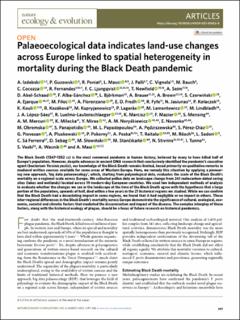| dc.contributor.author | Izdebski, A. | |
| dc.contributor.author | Guzowski, P. | |
| dc.contributor.author | Poniat, R. | |
| dc.contributor.author | Masci, L. | |
| dc.contributor.author | Palli, J. | |
| dc.contributor.author | Vignola, C. | |
| dc.contributor.author | Bauch, M. | |
| dc.contributor.author | Cocozza, C. | |
| dc.contributor.author | Fernandes, R. | |
| dc.contributor.author | Ljungqvist, F.C. | |
| dc.contributor.author | Newfield, T. | |
| dc.contributor.author | Seim, A. | |
| dc.contributor.author | Abel-Schaad, D. | |
| dc.contributor.author | Alba-Sánchez, F. | |
| dc.contributor.author | Björkman, L. | |
| dc.contributor.author | Brauer, A. | |
| dc.contributor.author | Brown, A. | |
| dc.contributor.author | Czerwiński, S. | |
| dc.contributor.author | Ejarque, A. | |
| dc.contributor.author | Fiłoc, M. | |
| dc.contributor.author | Florenzano, A. | |
| dc.contributor.author | Fredh, Erik Daniel | |
| dc.contributor.author | Fyfe, R. | |
| dc.contributor.author | Jasiunas, N. | |
| dc.contributor.author | Kołaczek, P. | |
| dc.contributor.author | Kouli, K. | |
| dc.contributor.author | Kozáková, R. | |
| dc.contributor.author | Kupryjanowicz, M. | |
| dc.contributor.author | Lagerås, P. | |
| dc.contributor.author | Lamentowicz, M. | |
| dc.contributor.author | Lindbladh, M. | |
| dc.contributor.author | López-Sáez, J.A. | |
| dc.contributor.author | Luelmo-Lautenschlaeger, R. | |
| dc.contributor.author | Marcisz, K. | |
| dc.contributor.author | Mazier, F. | |
| dc.contributor.author | Mensing, S. | |
| dc.contributor.author | Mercuri, A.M. | |
| dc.contributor.author | Milecka, K. | |
| dc.contributor.author | Miras, Y. | |
| dc.contributor.author | Noryśkiewicz, A.M. | |
| dc.contributor.author | Novenko, E. | |
| dc.contributor.author | Obremska, M. | |
| dc.contributor.author | Panajiotidis, S. | |
| dc.contributor.author | Papadopoulou, M.L. | |
| dc.contributor.author | Pędziszewska, A. | |
| dc.contributor.author | Pérez-Díaz, S. | |
| dc.contributor.author | Piovesan, G. | |
| dc.contributor.author | Pluskowski, A. | |
| dc.contributor.author | Pokorny, P. | |
| dc.contributor.author | Poska, A. | |
| dc.contributor.author | Reitalu, T. | |
| dc.contributor.author | Rösch, M. | |
| dc.contributor.author | Sadori, L. | |
| dc.contributor.author | Sá Ferreira, Ferreira | |
| dc.contributor.author | Sebag, D. | |
| dc.contributor.author | Słowiński, M. | |
| dc.contributor.author | Stančikaitė, M. | |
| dc.contributor.author | Stivrins, N. | |
| dc.contributor.author | Tunno, I. | |
| dc.contributor.author | Veski, S. | |
| dc.contributor.author | Wacnik, A. | |
| dc.contributor.author | Masi, A. | |
| dc.date.accessioned | 2023-03-15T14:23:02Z | |
| dc.date.available | 2023-03-15T14:23:02Z | |
| dc.date.created | 2022-05-20T13:04:01Z | |
| dc.date.issued | 2022 | |
| dc.identifier.citation | Izdebski, A., Guzowski, P., Poniat, R., Masci, L., Palli, J., Vignola, C., ... & Masi, A. (2022). Palaeoecological data indicates land-use changes across Europe linked to spatial heterogeneity in mortality during the Black Death pandemic. Nature Ecology & Evolution, 6(3), 297-306. | en_US |
| dc.identifier.issn | 2397-334X | |
| dc.identifier.uri | https://hdl.handle.net/11250/3058538 | |
| dc.description.abstract | The Black Death (1347–1352 CE) is the most renowned pandemic in human history, believed by many to have killed half of Europe’s population. However, despite advances in ancient DNA research that conclusively identified the pandemic’s causative agent (bacterium Yersinia pestis), our knowledge of the Black Death remains limited, based primarily on qualitative remarks in medieval written sources available for some areas of Western Europe. Here, we remedy this situation by applying a pioneering new approach, ‘big data palaeoecology’, which, starting from palynological data, evaluates the scale of the Black Death’s mortality on a regional scale across Europe. We collected pollen data on landscape change from 261 radiocarbon-dated coring sites (lakes and wetlands) located across 19 modern-day European countries. We used two independent methods of analysis to evaluate whether the changes we see in the landscape at the time of the Black Death agree with the hypothesis that a large portion of the population, upwards of half, died within a few years in the 21 historical regions we studied. While we can confirm that the Black Death had a devastating impact in some regions, we found that it had negligible or no impact in others. These inter-regional differences in the Black Death’s mortality across Europe demonstrate the significance of cultural, ecological, economic, societal and climatic factors that mediated the dissemination and impact of the disease. The complex interplay of these factors, along with the historical ecology of plague, should be a focus of future research on historical pandemics. | en_US |
| dc.language.iso | eng | en_US |
| dc.publisher | Nature | en_US |
| dc.rights | Navngivelse 4.0 Internasjonal | * |
| dc.rights.uri | http://creativecommons.org/licenses/by/4.0/deed.no | * |
| dc.title | Palaeoecological data indicates land-use changes across Europe linked to spatial heterogeneity in mortality during the Black Death pandemic | en_US |
| dc.title.alternative | Palaeoecological data indicates land-use changes across Europe linked to spatial heterogeneity in mortality during the Black Death pandemic | en_US |
| dc.type | Peer reviewed | en_US |
| dc.type | Journal article | en_US |
| dc.description.version | publishedVersion | en_US |
| dc.rights.holder | The authors | en_US |
| dc.subject.nsi | VDP::Humaniora: 000::Arkeologi: 090 | en_US |
| dc.source.pagenumber | 297-306 | en_US |
| dc.source.volume | 6 | en_US |
| dc.source.journal | Nature Ecology and Evolution | en_US |
| dc.identifier.doi | 10.1038/s41559-021-01652-4 | |
| dc.identifier.cristin | 2025974 | |
| cristin.ispublished | true | |
| cristin.fulltext | original | |
| cristin.qualitycode | 2 | |

